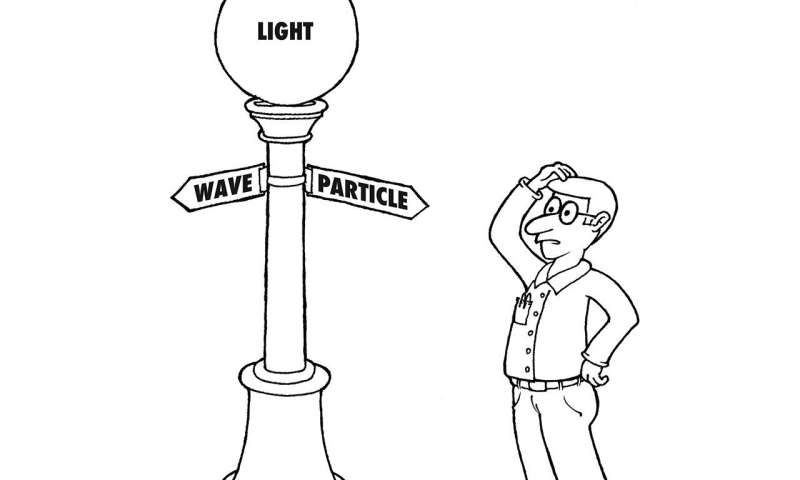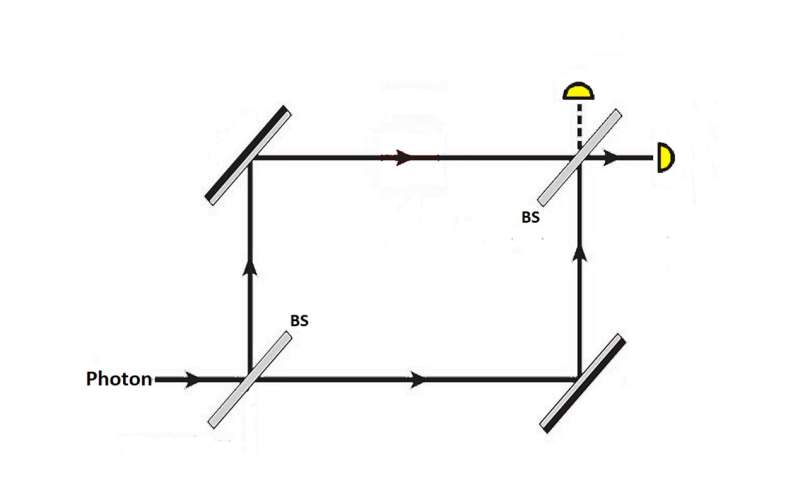For wave-particle duality and entanglement, progress is finally possible if we avoid the customary pitfalls

Photon duality remains a paradox because the photon is regarded as a simple, unitary object in space. Equally bad, massless radiation is interpreted via concepts drawn from mass-based physics.
The particle is a rest mass entity, and rest mass cannot exist without requiring/occupying space. The photon is an oscillatory energy entity (E = hf) and energy cycles cannot occur without requiring/occupying time.
Because the photon moves in space at the speed of light, it suffers infinite time dilation; its clock is stopped, making it stationary in time. Inertial rest mass is stationary in space. Entities that are stationary in a dimension, space or time, occupy an interval or volume in that dimension, making them common to the alternate dimension.
Hence, your desk is common to, and identical for, observers at successive time locations, while its rest mass requires and occupies an interval (volume) in space. Similarly, a photon's occurring, quantized energy is common to, and identical for, possible observers at successive space locations while its oscillation requires and occupies an interval in time.
Stationary entities reside in one dimension and are shared by multiple observers in the alternate dimension.
A stationary entity's primary (kinetic, unstored) identity is in the dimension where it resides: rest mass in space, photon oscillation energy in time. But each has a secondary (stored) identity.
At the speed of light, photon waves may diffract at an obstacle and expand widely in space. But they all collapse (nonlocally) at photon termination, which tells us that they depend upon photon energy in time to give their dispersed space presence a single (temporal) point of failure. Such dependence is that of E = mc2 storage; this means that the photon's second identity is waveform potential, relativistic mass.
Summary
These concepts—greatly condensed here—indicate the photon has two identities. Photon energy resides in time, making it immune to pinhole/slit diffraction; photon stored (potential) mass travels all available space paths as a collapsible wave determining probable photon termination. These two identities explain how the photon mimics particle impact and how it navigates the Mach-Zehnder interferometer. In addition, placing photon energy in time allows for bonding in that dimension, explaining photon entanglement and nonlocality.
Mimicking particle impact
A photon's energy in time can only terminate on a material target in space. With one occupying time and the other occupying space, the only way they can intersect is at a joint time and space point, namely an event, since the latter requires both rest mass and kinetic energy. Hence time-residing photon kinetic energy can release to (intersect) an orthogonal dimension (space) only discretely, i.e., at a space point, thereby mimicking particle impact. This energy transfer is the "discrete" aspect of photon behavior; it is also random on an individual basis.

Navigating the MZI
A Mach–Zehnder interferometer features two beam splitters (BS in figure 2) and two reflecting mirrors. The first beam splitter sends a photon at half strength along two paths. Mirrors on each path redirect to the second beam splitter producing wave-like interference. But a blocking detector on either path registers a single, particle-like termination. A duality paradox.
A single photon entering the first beam splitter has its space-progressing, potential mass waves divided in two while its time-residing energy is unaffected. These divided potential mass waves depend upon photon energy in time; both simply occur, no existence involved. If these waves cannot progress in space due to an obstacle, they will either trigger photon reception or cease to occur (collapse). If rest mass cannot progress in time it will cease to exist.
If a detector is on the upper path, photon (reduced) potential mass wave front will reach it with a 50% chance of terminating on it. If photon termination does not take place on this (blocking) detector, then local collapse of these blocked waves occurs. This converts the lower path from 50% to 100% probability of photon reception since the competing path has been eliminated. Although the detector on the upper path does not receive photon energy, it is a mistake to conclude that nothing was on that path and that the photon "chose the other path." If the photon does register on that detector, it is equally a mistake to conclude that nothing traversed the other path.
A detector on one path that does not register termination still blocks the passage of photon's potential mass wave, preventing any wave interference at the second beam splitter. The blocking of probability wave paths constitutes a physical change for radiation even if photon reception does not occur. Such a physical change is the basis of interaction-free (counterfactual) measurement as in the Elitzur-Vaidman bomb tester.
Entanglement and nonlocality
Rest masses may bond if they are space-adjacent; photon energies may bond if they are time adjacent.
Suppose a high energy photon enters a crystal and divides into two lesser photons, one blue and one green in frequency, each sending out potential mass waves in all directions. These blue and green photons retain their frequencies and will terminate separately. The two photon energies now constitute a joined whole, and being in time, they are now common to (shared by) all the observers on all the space paths their potential mass waves navigate. Polarization, being the property of an individual photon, is undefined for the whole.
At some point, blue photon potential mass triggers blue photon reception. Blue photon energy is transferred from time to a rest mass space target via a space/time event. Blue photon potential mass waves in space collapse instantly, nonlocally. Polarization of the blue photon is now defined, which instantly defines polarization of its time-conjoined partner; no space signal is required since the two photon kinetic identities (their energies) reside in time and are merely common for space.
Photon entanglement and its instantaneous change across space is the best proof we have that photon energy resides in the time dimension and is able to bond there.
Concluding remarks
Entities have a presence in a dimension; we have overlooked that for energy, despite E = mc2. Photon entanglement and photon duality are not what we thought. Nonlocal photon wave collapse in space is a consequence of energy residing in time. Is this wave collapse related to the collapse of the wave function? Perhaps, but discussion of that requires the space of my full paper.
This story is part of Science X Dialog, where researchers can report findings from their published research articles. Visit this page for information about ScienceX Dialog and how to participate.
More information:
Paul A. Klevgard et al. The Mach-Zehnder interferometer and photon dualism, Light in Nature VIII (2020). DOI: 10.1117/12.2575213
I have a Ph.D. from Northwestern University. My experience includes teaching at the university level, staff member at Sandia National Laboratory and software engineering in Silicon Valley. My specialty is physical entities and their presence in dimensions; much neglected, in little demand, this specialty falls somewhere between two stools: academic philosophy and theoretical physics.